How To Use A Black Accent Wall For Your Interior Designs
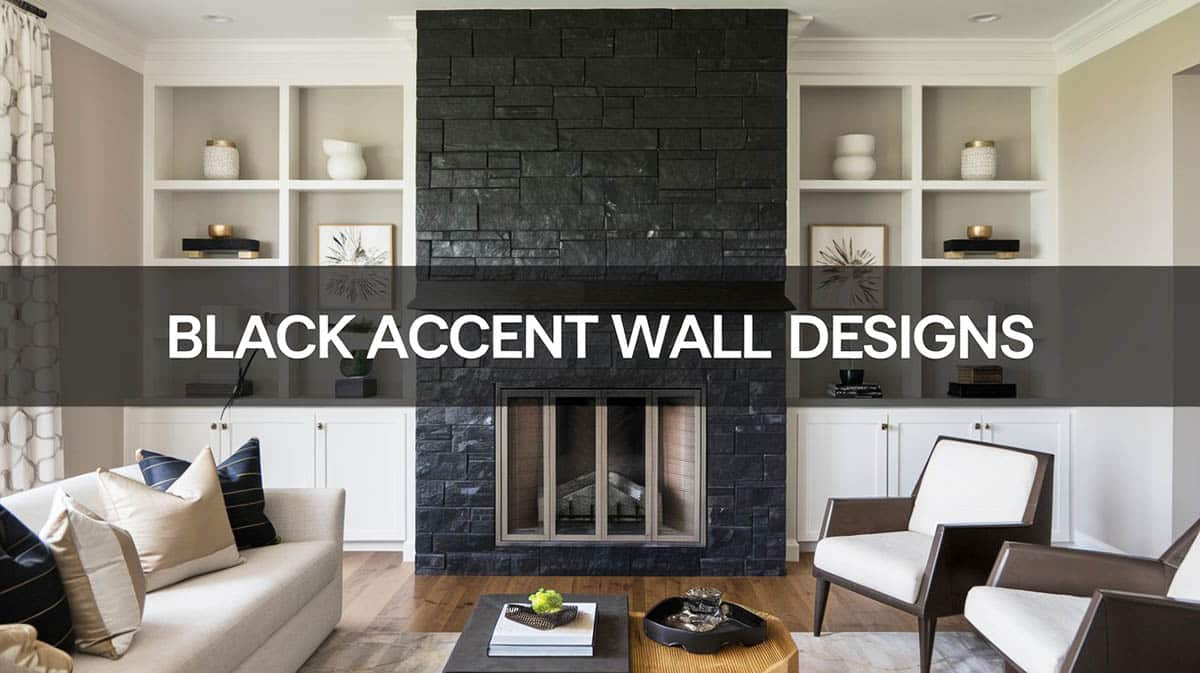
Most homeowners hesitate to use the color black in their houses because of the wrong perception that a dark color may dull down a room. This is a pure misconception because the color black is actually a stunning addition to an interior, and it does not overpower the room. One of the most effective ways to introduce the color black into a space is through an accent wall. Aside from being stylish, there are many other reasons why you should go with a striking black accent wall.
Benefits of adding a black accent wall to a space:
- Brings urban sophistication and modern finesse to a space.
- Offers design flexibility and versatility. The color black is as flexible as the color white in terms of design, and it can suit any color palette.
- It can break the monotony and starkness of a color scheme.
- Adds depth and drama to a space.
- A black accent wall instantly becomes the focal point of a room and creates a statement.
- Gives the space a more curated and contemporary appeal.
- Suits any design style and decor, whether traditional, contemporary, or modern.
- A black accent wall can usher in elegance without feeling too overwhelming.
A black statement backdrop can either make or break the overall look of your home, so you have to use it wisely and find the perfect spot for it. Below, we have created a list of the most effective ways you can use it in the different areas of your home, along with some design tips to help you pull off this unique look.
Black Accent Wall in the Bedroom
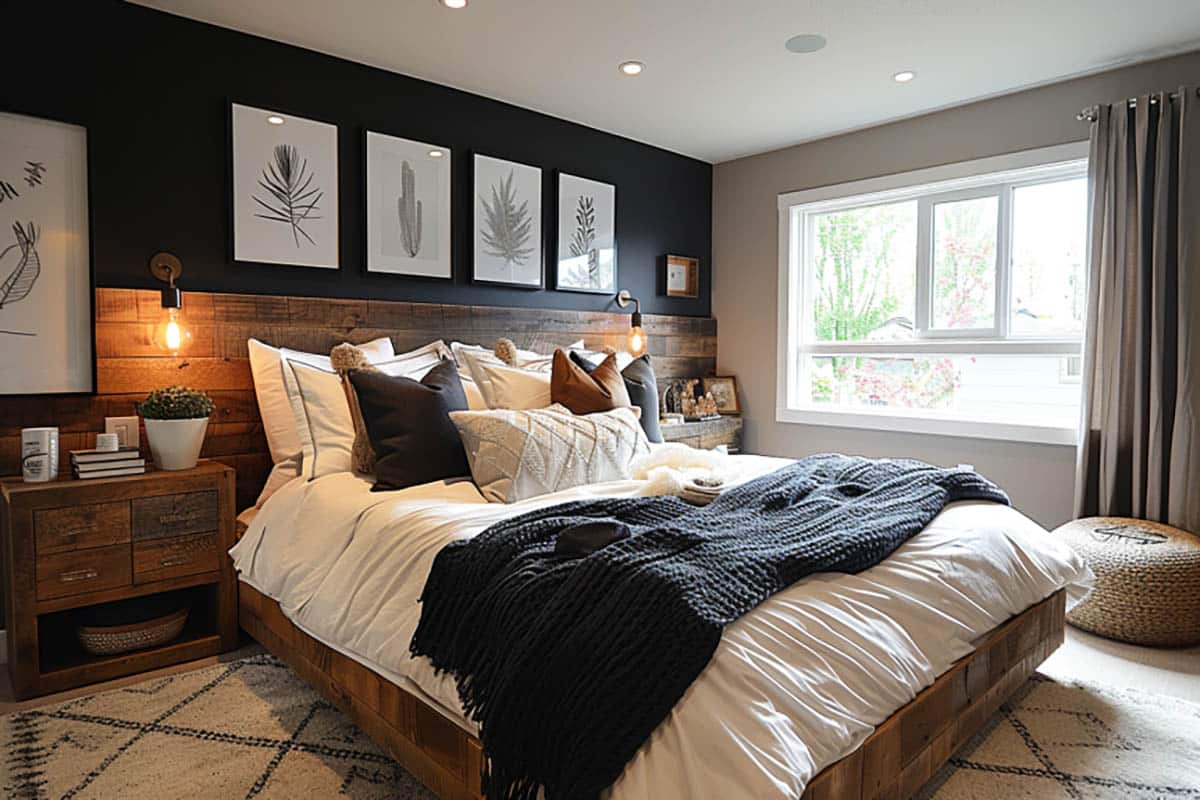
Headboard: The most common place to use a black accent wall in the bedroom is the headboard. Finishing a wall with either black paint or black wallpaper can instantly become the focal point of a bedroom. It also keeps the attention in the room focused on the most important feature in a bedroom, which is the bed.
Side Wall or Gallery Wall: Of course, the headboard isn’t the only place that you can use a black accent backdrop in the bedroom. Alternatively, it can be a side partition, and instead of being kept blank, you can use it as a gallery wall wherein pieces of artwork or framed pictures may be hung. Built-in shelving with books or minimalist accessories is also a great way to finish a black accent backdrop in the bedroom, as it can add character to the space.
Design Tip: Combining a black accent backdrop with dark colored paint is not the best idea for a bedroom setting because it will make the room look heavy and overwhelming – defying the very essence of what the bedroom is for, which is rest and relaxation. Instead, paint the rest of the walls of the bedroom in a shade of white and use light pastels to keep your bedroom soothing.
Repeating the color black in other room elements, such as the accessories and furnishings, will keep your color scheme tied together. The pops of color will also add to the level of sophistication and elegance of the bedroom. Just make sure that you don’t overuse it. Remember! Unless you are going for a “black and white” theme, the key is to feature the color ebony with just the right amount to prevent the space from looking too heavy.
Ebony accent walls in bedrooms especially work for spaces that are mostly clad in white furnishings and furniture pieces as they break the monotony and starkness of the room. Printed bed covers and pillows can tie together the colors by showcasing pops of color that match the accent paint. See more accent wall color ideas here.
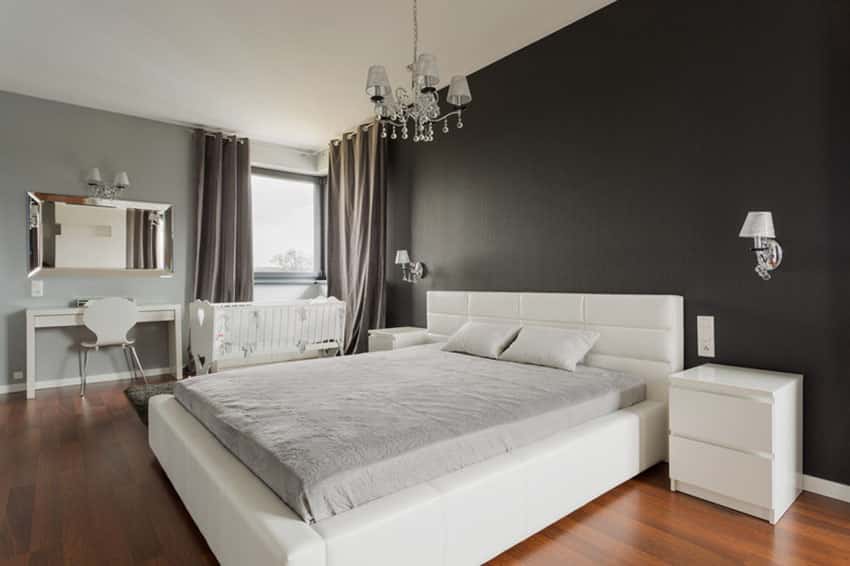
To keep a charcoal-colored accent wall bedroom design from looking too dark, one can add plenty of lighter contrast. Lighter color backdrop paint and furniture pieces can be used to lighten up the space and compliment the drama of a black wall. See more black bedroom designs here.
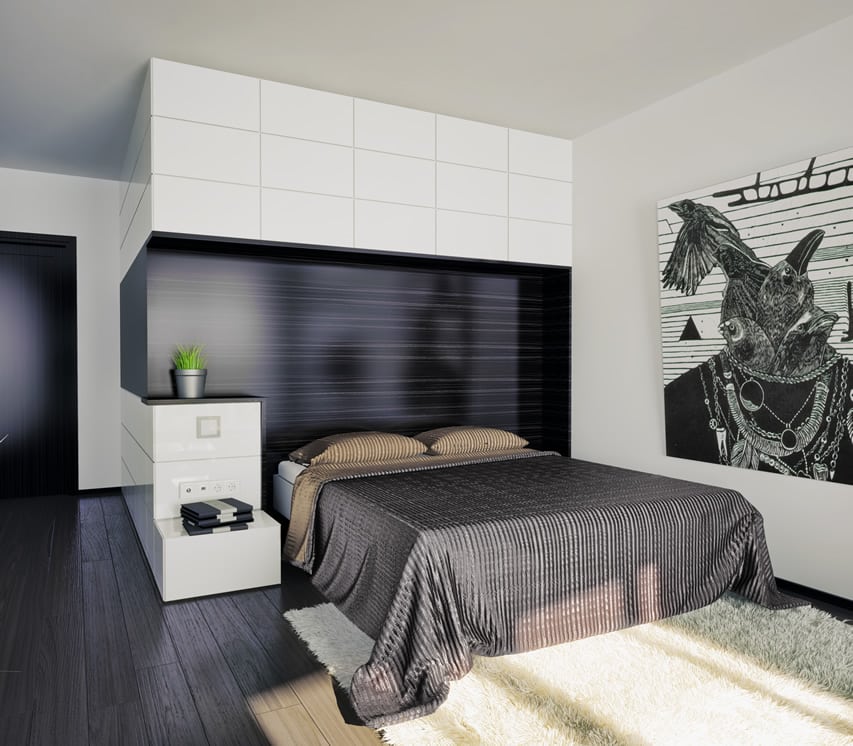
This luxe-modern room offers a built-in textured feature with graining patterns set behind a platform bed. The colors within its design go well with other elements such as the dark-wood plank floor, the door and artwork.
Black Feature Wall in the Living Room
Gallery Wall: A black accent wall in the living offers a beautiful backdrop for several items that you want to showcase in your home. To make your painted black accent wall in the living room less boring, you can use it as a gallery wall where a collection of framed family photos may be hung.
Again, an ebony accent backdrop instantly draws attention towards it, so it is also fitting to use for displaying other items that you want to highlight, like a favorite artwork or modern art. It can also be finished with a floating ledge, where your favorite accessories can be placed.
Accent Wall with Decal or Mural: If you are not a fan of knick-knacks and are aiming for a more minimalist look, you can use a decal to add character to a painted accent backdrop.
Decals are very “in” nowadays and are available in a myriad of designs, like texts or quotes in calligraphy fonts, cityscapes, or silhouettes of objects. Decals are well suited for obsidian accent walls in contemporary and modern living rooms.
Alternatively, you can add character to your living room by using textured wallpaper instead of the usual paint finish. Textured wallpaper adds depth and dimension to the overall look of your living room without being too heavy on the eyes.
Printed black wallpaper is also another excellent option. Your choice of pattern will greatly depend on the final look and style you want to achieve for your living room. For example, geometric or striped ebony wallpaper is for modern and contemporary living rooms, floral prints and motifs for traditional living rooms, and black-with-gold patterns are for Hollywood regency-style living spaces.
Bricks are a unique finishing material that can be explored for a black accent wall. Aside from providing contrast in terms of texture, an brick accent backdrop also renders a strong industrial vibe. This type of accent wall surely draws all the attention, especially when combined with light-colored flooring, walls, and built-in storage systems.
Texture and pattern are other visual elements that can amp up the look of a black accent wall. This living room showcases a fireplace bordered with ebony strip tiles and stone. Repeating the color ebony in the furniture, stairs, and accessories, such as the vases and throw pillows, keeps the overall look tied together harmoniously
Black Kitchen Wall
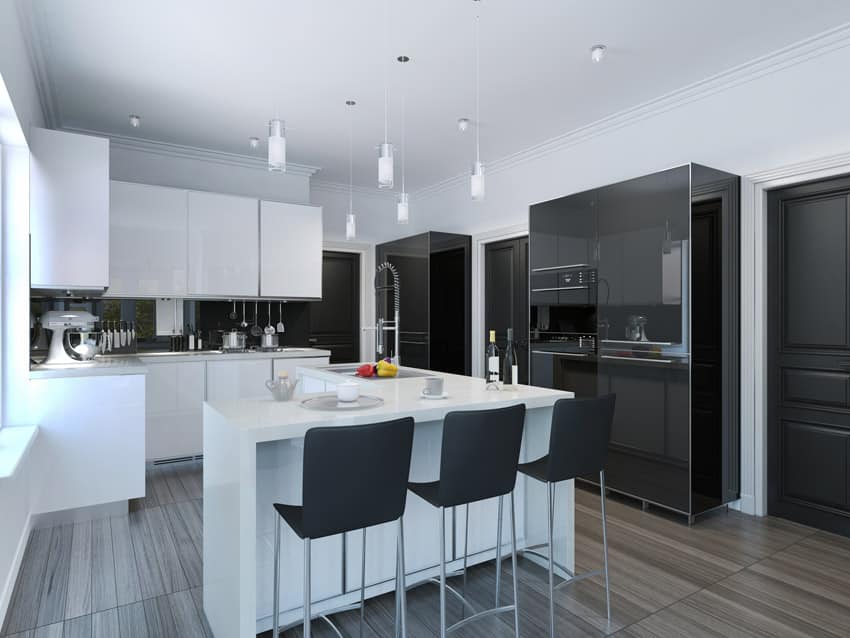
The color black, in general, is not a common color we see in kitchens simply because most of us feel that it is too heavy for the eyes, and it takes away the lightness and airiness of the space. Since the kitchen is also filled already with a lot of elements like shelves with pots and pans, a display of dinnerware, and a large span of cabinets and appliances, — a light-colored backdrop, usually white, is more favored to make the space less overwhelming and visually spacious.
Although unconventional, making the color black a part of your kitchen’s color palette can bring in a totally new experience and a big visual difference. Because it veers away from the usual color schemes that we see in kitchens, such as neutrals and warm shades of brown from natural woods, it adds a unique vibe to the space.
When used properly, a black accent wall can make your kitchen look more elegant, stylish, and sophisticated. There are clever ways to add in a black accent wall in a kitchen such as cabinets clad in ebony, furnished with black countertops, or a dark colored backsplash covered in tiles.
Black Cabinets and Countertops: An accent wall does not always have to be a wall, per se. In a kitchen setting, at least one to three walls are allocated for a whole span of kitchen cabinets (depending on the layout), and this is a good way to introduce your black accent wall.
Instead of painting a wall black, you can directly apply the color to the cabinet. Being the most dominant feature in a kitchen, cabinets finished in black instantly amp up the character of the space while also serving as the main focal point.
Depending on the style of your kitchen, you can choose different finishes for your black cabinets. For contemporary kitchens, a partition with black cabinets in matte or semi gloss paint finish will do the trick.
For a more modern setting, upgrade the look of kitchen cabinets in a high gloss black finish using high pressure laminates, veneers or glossy ducco finish. A more traditional kitchen, on the other hand, is suited with an ebony colored wood stain.
Black Backsplash: If you do not want to paint your kitchen cabinets in black, another way to create a black statement backdrop in the kitchen is through the backsplash. A wall finished with black glass mosaic tiles will surely bring in a stylish vibe, especially if paired with contrasting light-colored cabinets.
Alternatively, a black backsplash will also work when paired with black kitchen cabinets, as long as your backsplash has pops of metallic or grayish accents in it. Aside from mosaic tiles, other materials like black natural stone or granite, black subway tiles, or black geometric tiles are also good options to choose from.
Design Tip: If black is a too strong color for your kitchen, you can explore other alternative colors, like charcoal which will produce the same level of sophistication and dramatic effect. Also, balance out your black statement backdrop with light colored elements in the kitchen.
Create contrast with the accents by using metallic accessories, a glass pendant over the counter or light colored bar stools. You can also never go wrong with pairing a black accent wall with white countertops, as it levels out the overall look of your kitchen.
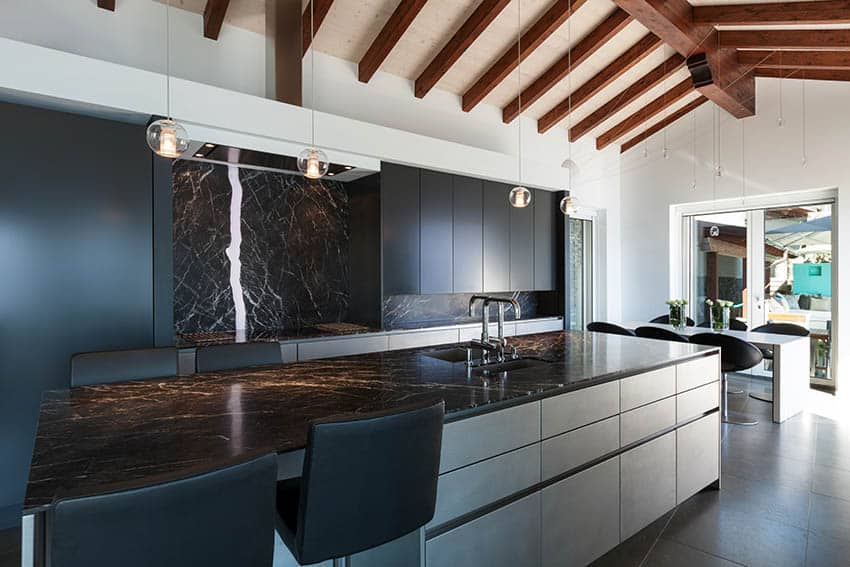
This ultra-stylish kitchen makes use of a matte black finish for the kitchen cabinets and an exotic granite backsplash. The undertones from the dynamic veining pattern of the stone provide a dramatic effect and urban finesse to the space. To achieve maximum elegance and sophistication, the dark colored accent wall is complemented with black colored furniture pieces and glass lighting fixtures and accessories.
Black Color Wall in the Dining Room
The best way to furnish a black accent wall in the dining room is to keep it simple — a single piece of framed artwork, a hanging metal art or a mirror is sometimes just enough to do the trick. If this looks too bare for you, a console table or buffet table with two lamps at each end may also be added to the setup. Plain black paint or textured wall finishes like wallpaper, wood panels, or laminates are some materials that can be explored for black accent walls in the dining room.
Design Tip: Black chalkboard paint is another unique finishing material that you can explore for an accent wall in the dining room. A black chalkboard accent wall may be used for notes, reminders, or wall art. And if you have kids, it offers them a blank canvas where they can explore their creativity. Your family can also leave notes to one another, post reminders, and keep track of each other’s schedules. Aside from being functional, it brings a fun and industrial vibe to a space.
For more traditional style spaces, wainscoting and wood paneling are some other wall treatments that can be explored for a black accent wall. Combined with white trim and moldings, the black accent wall contributes a pop of color without being too loud and overwhelming. In addition, it matches the timelessness and refined flair of this classic style space. Using accent colors on a tray ceiling is another way to draw the eye and create visual interest.
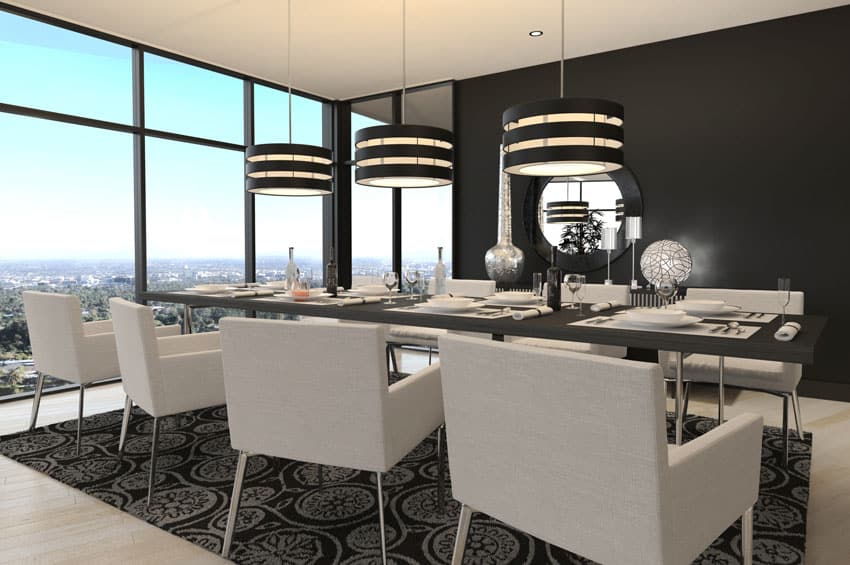
Stylish, elegant, and sophisticated, this modern dining room showcases a classic black-and-white pairing for the design elements of the space. The best thing about this dining room is that it has large windows which take maximum advantage of natural sunlight, making the space appear airy and bright, while also lessening the heaviness of the matte black accent wall.
Black Feature Wall for the Office
A home office does not always have to be a separate room in the house. In some cases where the space is limited, home offices are usually placed in a corner of a room or a nook. And since it may not be enclosed with partitions, a good way to delineate the home office from other areas of the house is to use an accent wall. It does not only work by directing visual attention to something, but it also keeps a space distinct and separate.
Here are some ways to use an ebony accent wall in the home office:
Floor-to-Ceiling Bookshelves: If the space permits, the statement wall in the home office may be furnished with built-in floor-to-ceiling bookshelves. A full span of storage maximizes every inch of vertical space, and aside from being functional, it also contributes a different character to your room.
To prevent your design from looking too boring, make sure to combine different types of storage systems for your bookshelves. Instead of going for the conventional box-type individual compartments, you can combine shelves or ledges with a bit of closed cabinetry at the bottom of the overhead part of the wall.
The accessories that you display on the bookshelves are also significant parts of the space, as these small elements will add up to the overall vibe of the home office. Take advantage of the storage space available and keep a variation of your accessories by combining books with statement accessories or framed artwork.
The Wall Behind the Desk: The main furniture pieces in a home office are the desk or office table and the chair, and an effective way to direct focus and attention to it is by putting a dark accent wall behind it. Wallpaper, paint, laminates, wood paneling, and special textured wall finishes are some materials you can explore for this.
Design Tip: Keep it simple with a black painted accent wall. You can never go wrong with a simple painted accent wall. For a home office space, a plain painted wall offers flexibility since it may double as a gallery wall and a memo wall. You can also add a single floating shelf if a full floor to ceiling storage looks too overwhelming for your taste.
As mentioned earlier, a home office does not always have to be an enclosed room in the house. A small backdrop niche can be dedicated for the same purpose, while only using minimal furniture pieces and furnishings. Using an accent wall makes the space distinct and separates it from all the other adjacent areas in the house.
Black Bathroom Statement Wall
Even small spaces like bathrooms can benefit from ebony accent walls. Contrary to popular belief that dark colors can often make your space look smaller, black – when used sparingly- works even for shower areas or even powder rooms. As for any room, an ebony statement backdrop in a bathroom can add sophistication and heighten the level of visual drama in the space.
Shower Area: The shower area is the most common place for an ebony accent wall in the bathroom, with glass mosaic tiles as the most popular finishing material. Alternatively, ceramic and porcelain tiles may also be used, depending on the style of the bathroom. Strip tiles and geometrically shaped tiles in ebony are also excellent choices, particularly for contemporary and modern bathrooms.
Typically, the wall where the shower fixtures are used as a statement backdrop in a shower area setting, but the side may also be used. And to make the most out of a focal point, niches that double as toiletry holders may be built in.
Lavatory Wall or Vanity Wall: The space where the vanity or lavatory is placed is also another perfect spot for an ebony statement backdrop in the bathroom. But unlike the shower area, which is usually limited to finishing materials like tiles, there are more material options for a lavatory partition since it does not get wet as much. Wallpaper, paint, and natural stone are other alternatives that can add character to an ebony statement backdrop.
Design Tip: If you decide on using mosaic tiles for your statement backdrop in the bathroom, look for the variants that have metallic and silvery accents since they complement well with stainless steel and chrome faucets. Also, you can never go wrong with white-colored bathroom fixtures like lavatory sinks and water closets as they contrast well with a statement wall. Black and white bathrooms can provide plenty of contrast without the room appearing too dark.
Tips for Designing Your Walls
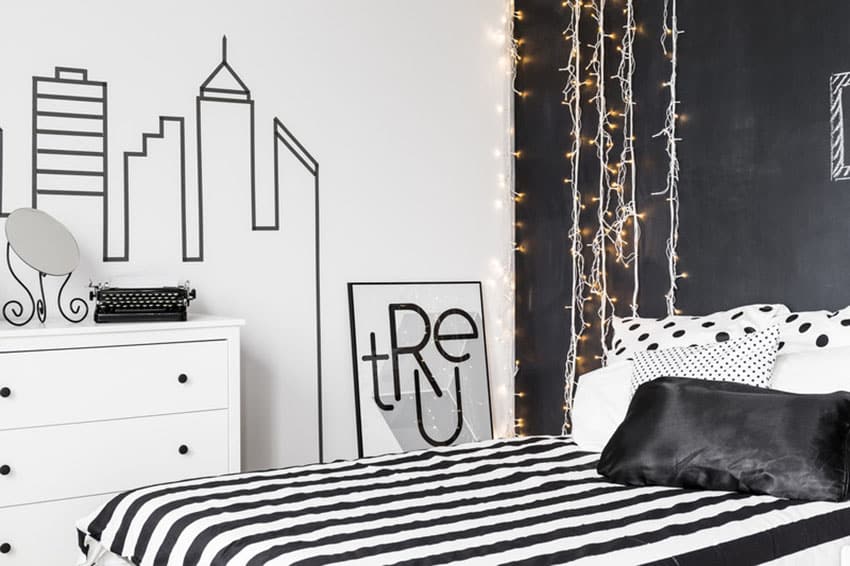
Find the Right Spot. The key to pulling off a charcoal statement backdrop for any type of space is to find the right spot. Ideally, opt for a space that receives plenty of natural light so it does not look too gloomy or heavy. You can never go wrong with a divider with a window beside it.
Explore Pattern, Texture and Style. A charcoal accent can easily adapt to different decorating styles with just a few simple tweaks. There are different material finishes that you can explore depending on the interior design style you aim to achieve.
A statement backdrop clad in ebony wallpaper is highly suited for a vintage, eclectic, or mid century modern space. Textured walls, on the other hand, are the best options for traditional, rustic, and Mediterranean inspired interiors.
Patterns and prints also make a statement backdrop more interesting. Aside from printed backdrop covering, stencils and stamps provide an easy way to decorate an ebony accent backdrop. Decals and stickers are also effective alternatives if you want to add more decorative drama.
Keep Your Furniture Pieces and Accessories Well-Edited. An ebony accent backdrop is a bold design element in itself, so it must be combined with the right accessories and furniture pieces. Keep your furniture simple and your accessories minimal to prevent them from competing with the strong character of a statement backdrop.
Contrast. Bold contrast creates a bigger impact. You do not want to pair your charcoal accent backdrop with dark colored elements unless you want your space to look monotonous. Instead, opt for light colored furniture pieces and accessories as they pop out nicely against the dark background.
Take into Account the Colors of the Other Walls in the Space. For the other walls in the space, you can use white, cream, or ivory colored paint to keep the space from feeling too closed in. The same thing goes for the ceiling; use a light-colored paint, preferably white, to balance out the color scheme of the room.
Complement with the Proper Accents. When accessorizing an ebony accent backdrop, you don’t always need to stick with a charcoal-and-white color scheme. Bright-colored decorative elements pop out beautifully against a dark colored background.
Blue and green, specifically the lighter tints, also make a bold statement and contrast beautifully with a dark statement backdrop. Introduce your accent color through accessories like vases or soft furnishings like curtains, drapes, throws, and pillows. Artwork and furniture are also other ways in which you can use bright accent colors.
For related designs, visit this page for more ideas for accent walls.

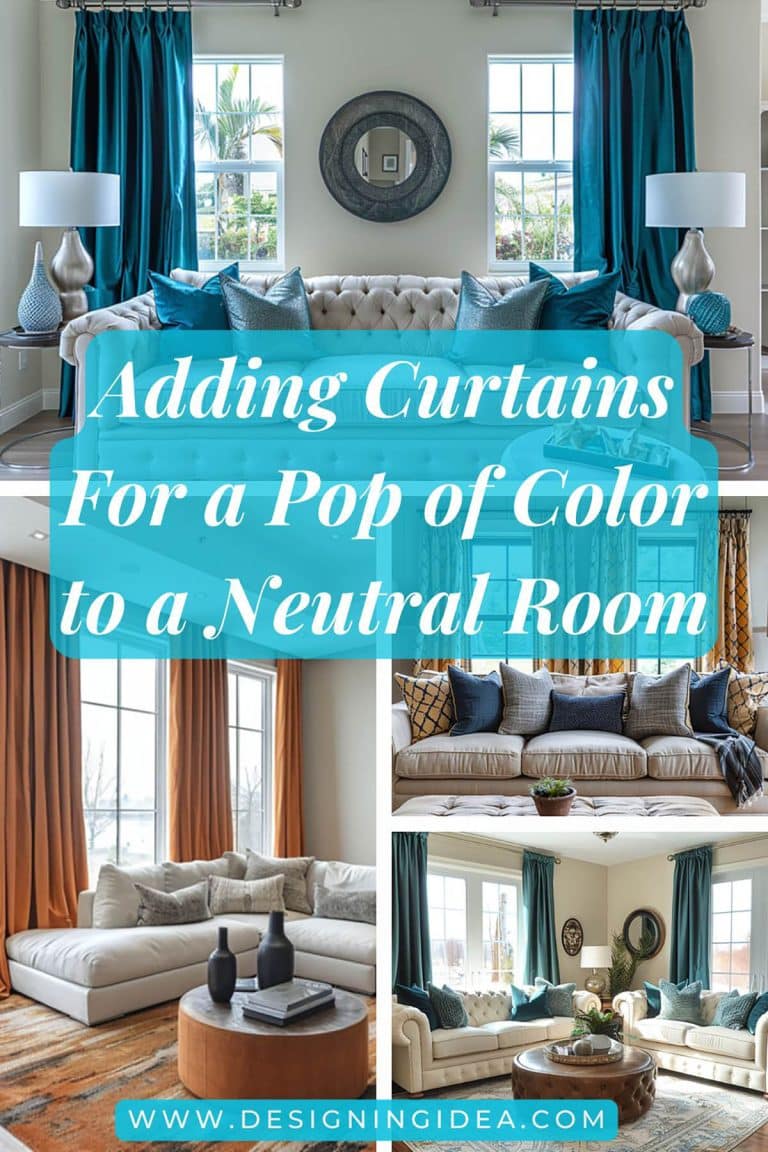
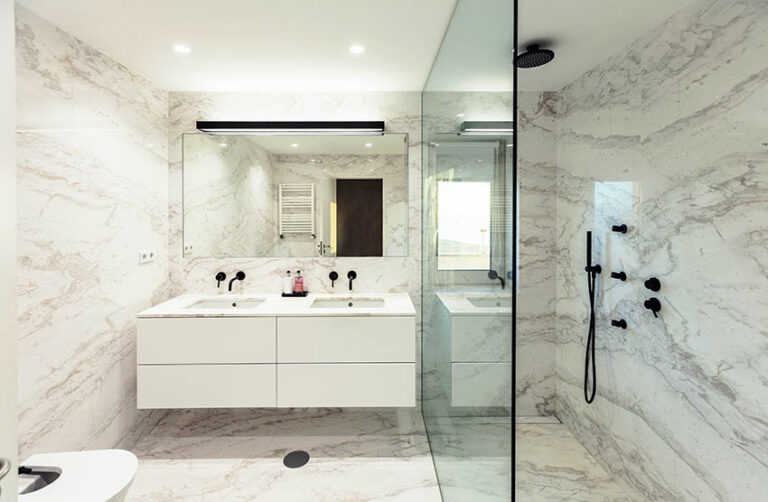
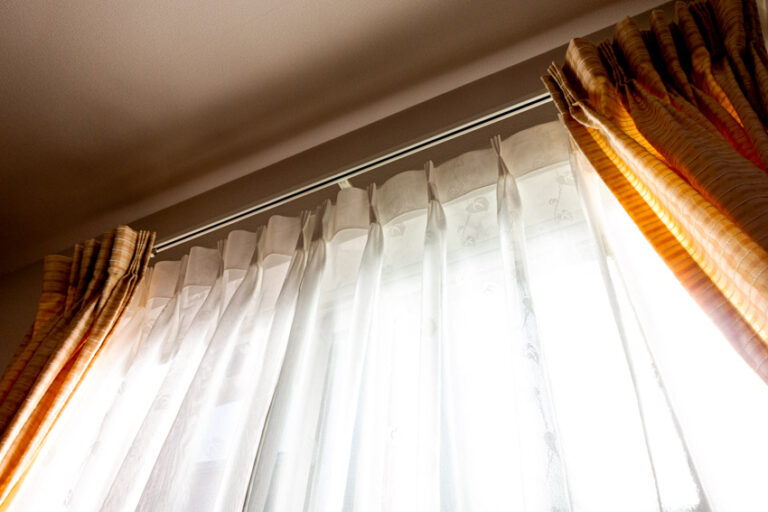
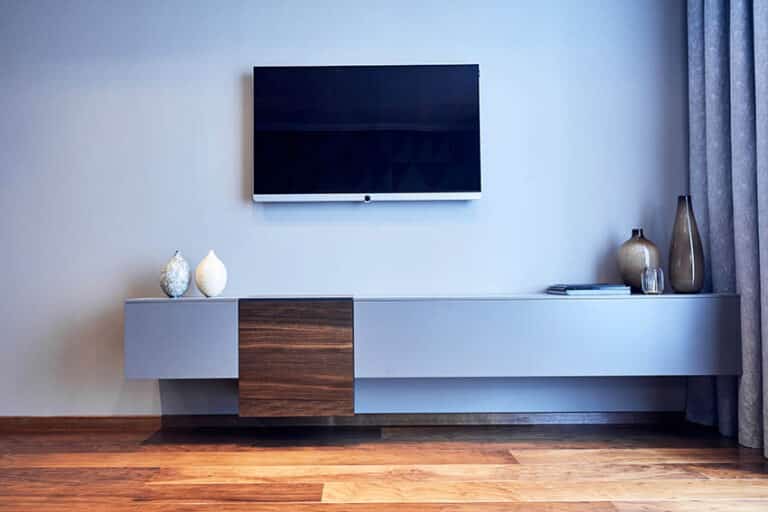
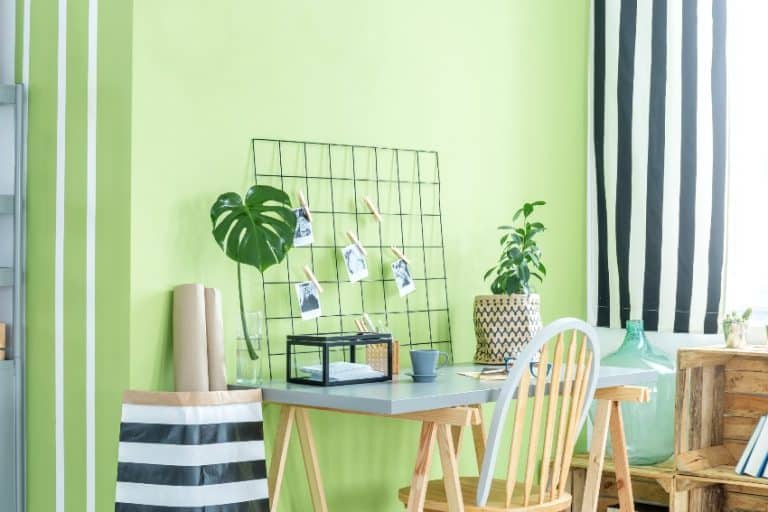
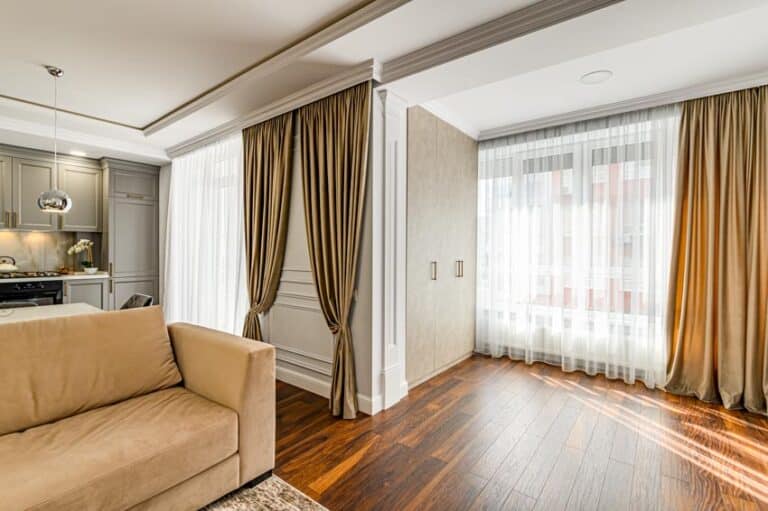
It was really exciting to read how black accent walls can be used in multiple areas of the house. With how boring my house currently looks, I’ve been wanting to find a way to make it pop out more in areas like the living room where people spend most of their time. I’ll take your advice about this and look for any painting professionals in the area that can help us paint some of our best accent walls with black color.